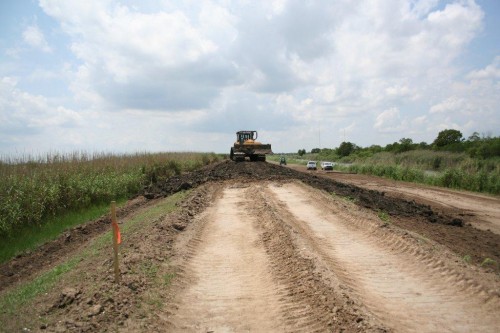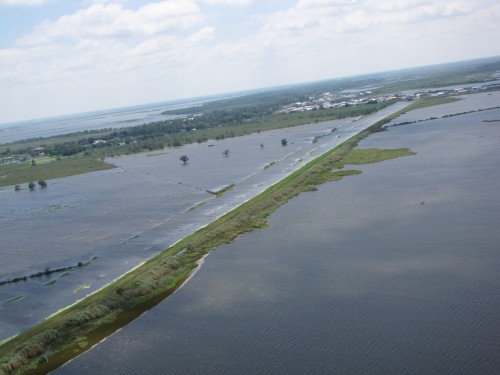
Hurricane system cheaper as do-it-yourself project
May 16, 2012
Alice Ann Belanger
May 17, 2012Wetlands damage is a necessary byproduct of flood-protection construction, one that requires restoration efforts elsewhere to offset the environmentally negative impacts.
The process, called mitigation, has long been a conscious element in the minds of stakeholders of coastal restoration and flood protection projects. The U.S. Army Corps of Engineers, through an esoteric formula, calculates how many acres need to be created to offset the impacts.
Entities create acres by purchasing credits at mitigation banks, organizations that oversee creation projects in marked areas. Some locals complain that the banks’ prices are largely unregulated.
“Mitigation banks set their own prices, so they can hold you hostage if they want,” said Restore or Retreat Executive Director Simone Maloz.
The cost issue was compounded last year when the corps announced it would implement a new policy – the Modified Charleston Method – to calculate the mitigation formula.
Dwayne Bourgeois, director of the North Lafourche Conservation, Levee and Drainage District, praised the transparency (spreadsheets replaced excusatory narratives) of the MCM, but lamented heightened costs for projects that will ultimately save wetlands from disappearing.
“They basically set the outcome to increase the amount of mitigation required,” Bourgeois said. “It’s a nice spreadsheet, it’s not subjective, but it definitely has an agenda in that it will force about a 3.1-to-1 average mitigation ratio for when you destroy an acre of healthy marsh.”
Bourgeois was one of a group of local levee district directors to meet directly with Col. Edward Fleming, district engineer and commander of the corps’ New Orleans District. Bourgeois said he appealed for special consideration because coastal Louisiana is a unique landscape, echoing other locals’ concerns.
“We’re doing this in the delta, where we’re just trying to hold a line in the sand,” Bourgeois said. “We’re not trying to gain any ground here. We’re just trying to live where we live and keep everybody as safe as we can.
“I spoke to (Fleming) as recently as last week,” Bourgeois said. “I think he’s still trying to work on it.”
According to The Time Picayune, Fleming has said MCM was implemented for two major reasons: to increase the amount of acreage created due to ineffectiveness in the previous process and to make equating the damages more transparent.
Maloz, the only paid employee under ROR, keeps tabs on about six major projects, including Morganza to the Gulf.
She said future Morganza projects would be impacted in the same vein as all major projects, likely driving up the cost even higher on a decades-old super-system project that is already approaching $7 billion and hasn’t yet solicited one federal dollar.
“I know, in general, the whole application of the Modified Charleston Method is going to be hurtful in a respect of time and money, and it’s one of those things, they simply don’t have to apply that method,” Maloz said. “The New Orleans District of the Corps does not even have to follow the Modified Charleston Method.”
Keith Lovell, a coastal management administrator with the state Department of Natural Resources, said the state has run mock-ups using the MCM-implementation on Morganza projects.
“More often than not, you’re looking at a 3.1, 3.5 or even greater than a 3.5 ratio on those levees and future levees,” Lovell said. “It’s the once every 10 or 20 year projects that we’re fearful that the MCM is going to severely impact.”
U.S. Sen. Mary Landrieu sits on the Committee of Appropriations, which directs funding to the corps. She said mitigation is “No. 1” on her list of Louisiana problems that need rectification.
Instead of focusing on the amount of acreage created, Landrieu said the emphasis should be placed on preserving created acres with smarter implementation and better oversight. Tripling the ratio, she said, would make projects “prohibitively expensive,” so she will continue to advocate for a 1-to-1 ratio.
“That process has not been as effective as it could be, but under no circumstance can we allow the corps or the federal government to change that ratio because it would make Morganza to the Gulf twice as expensive,” Landrieu said.
Landrieu also said she will examine Louisiana’s mitigation banks to ensure “taxpayers are not overpaying for the mitigation requirements of all of our development projects.”
Kerry St. Pe’, director of the Barataria-Terrebonne National Estuary Program, said Morganza mitigation should be minimal because a large portion of construction is following a footprint.
“Usually when you build levees, it does impact wetlands, but in this case the construction of the levees are on existing hydrologic barriers, on existing road beds, at the back of the natural levee, so the damage is really going to be kept at a minimum,” St. Pe’ said.
Damages should be compensated, he said, even through the system will naturally preserve wetlands growth on the interior. Marsh creation outside of the system is needed to add another layer of defense and knock down excessive storm surge, he reasoned.
“In this location, we cannot, we cannot live here with just levees,” St. Pe’ said. “If there’s damage to the wetlands, mitigation has to occur. We would rather see wetlands created on the outside of the system.”
U.S. Sen. David Vitter said he continues to advocate for a less-expensive alternative to the Modified Charleston Method and locally run, locally located mitigation banks.
Vitter said the third prong of his attempted mitigation reform is to link mitigation costs with coastal-restoration project funding.
“If you ask Louisianans about wetlands, the wetlands issue is coastal land loss, the need for coastal restoration, not buying or preserving more piney woods 200 miles from the coast,” Vitter said. “I’m trying to make that connection in practice.”
U.S. Rep. Jeff Landry said he hopes to unveil legislation that would prohibit the corps from “forcing the MCM onto local communities” by the end of the month.
“Despite thousands of acres being protected, the levee district is forced to mitigate for the hundreds of acres they damage in building the levee,” Landry said via email. “It just doesn’t make sense, and the Modified Charleston Method will make this problem even worse.”











